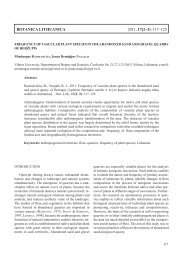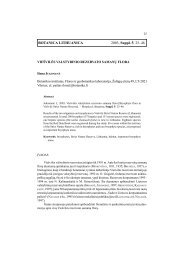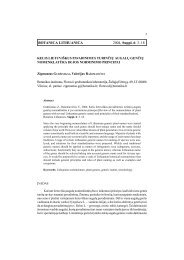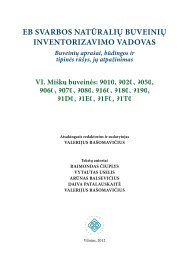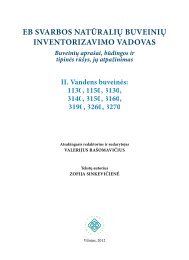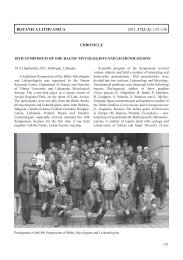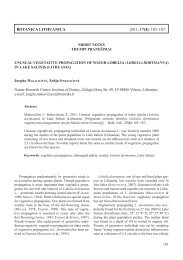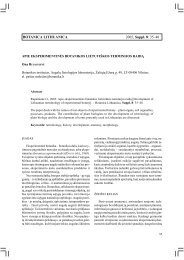FUNGI AND LICHENS IN THE BALTICS AND BEYOND XVIII ...
FUNGI AND LICHENS IN THE BALTICS AND BEYOND XVIII ...
FUNGI AND LICHENS IN THE BALTICS AND BEYOND XVIII ...
Create successful ePaper yourself
Turn your PDF publications into a flip-book with our unique Google optimized e-Paper software.
forests (Abies nephrolepis) and mixed forests (Picea spp., Pinus koraiénsis, Abies<br />
nephrolepis, Acer spp., Betula spp.) were investigated. The lichen flora of Primorye Region is<br />
exceptionally rich and diverse not only in old-growth and pristine forests, but in disturbed and<br />
secondary communities as well. Some species like Usnea longissima that we are used to treat<br />
as very good indicators in other regions loose here their indicator value. Due to these reasons,<br />
it is not so easy to select the most sensitive and threatened core of the flora. On the current<br />
stage of investigations it is possible to propose only preliminary list of the main indicator<br />
species.<br />
<strong>LICHENS</strong> <strong>IN</strong> A CHRONOSEQUENCE OF 16-236 YEAR-OLD KELO TREES<br />
P. LÕHMUS 1* , A. LÕHMUS 1 , J. KOUKI 2<br />
1 Institute of Ecology and Earth Sciences, University of Tartu, Vanemuise st. 46,<br />
EE-51014, Tartu, Estonia<br />
2<br />
School of Forest Sciences, University of Eastern Finland, P.O. Box 111, FI-80101 Joensuu,<br />
Finland<br />
*E-mail: piret.lohmus@ut.ee<br />
Standing (debarked) dead trees support diverse and unique lichen communities in<br />
boreal forests. At the trunk scale, tree species, wood exposure and decay stage are known to<br />
have key importance for lichen richness and composition, but the role of exposure time has<br />
not been explored. We used a unique study system of 25 dendrochronologically dated kelo<br />
trees (slowly decaying standing pines) in Hietavaara primeval forest, East-Finland, which<br />
spanned over 16–236 years since their death. The abundance of lichenized and allied fungi<br />
was investigated at every 0.5-m section of each trunk, from the base up to 3.5 m, and some<br />
additional characteristics of each kelo were described<br />
In total, 88 species were found. That exceeds considerably the known richness<br />
numbers found in comparable studies. The time since kelo death was not related to lichen<br />
species richness (multiple regression) or their species composition (MRPP test). However, the<br />
kelos that had died at a younger age and were more decayed by now had more species. The<br />
variation in lichen community composition was best explained by the average decay stage and<br />
the proportion of exposed wood. Comparisons of the species composition along the height<br />
sections provided support to the prevailing practice to sample lichens up to 2 m heights in<br />
dead trees (sections >1.5 m did not add specific species).<br />
We conclude that the main “time frame” for the dispersal and establishment of woodinhabiting<br />
lichens is restricted to a few decades. In the long term, lichen communities appear<br />
to be most affected by the direct microhabitat characteristics, and their development, both<br />
during the life and after the death of the trees.



